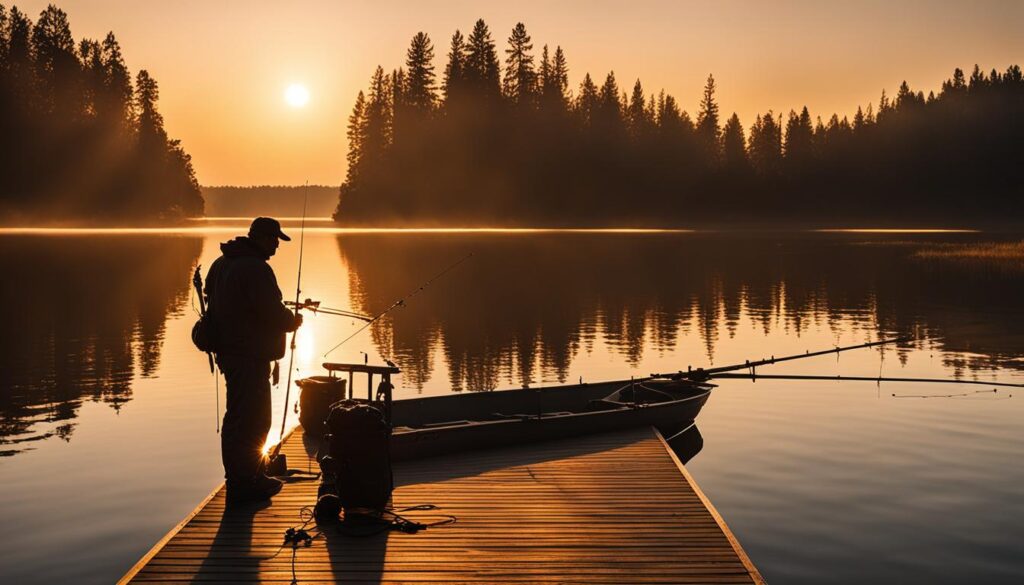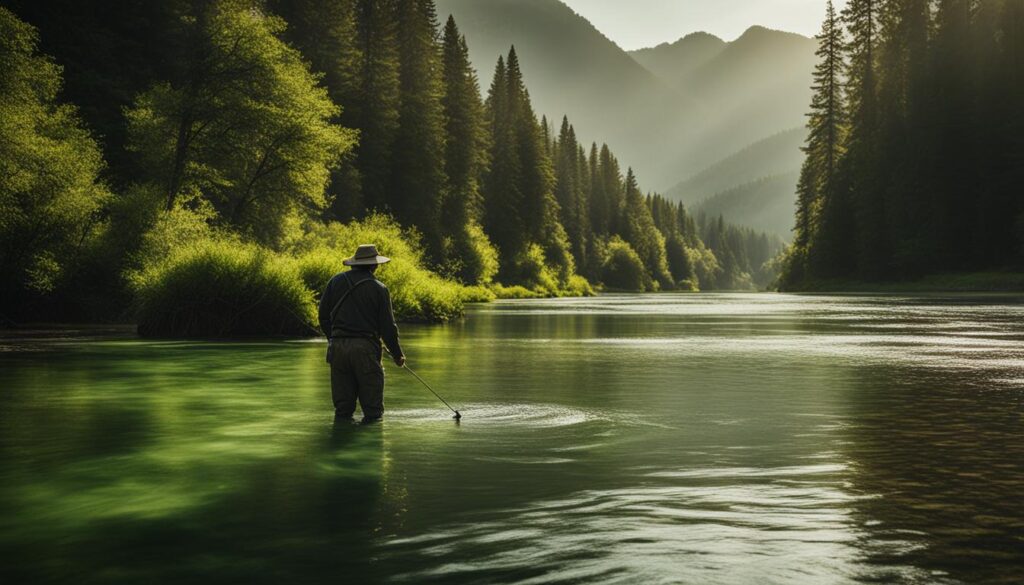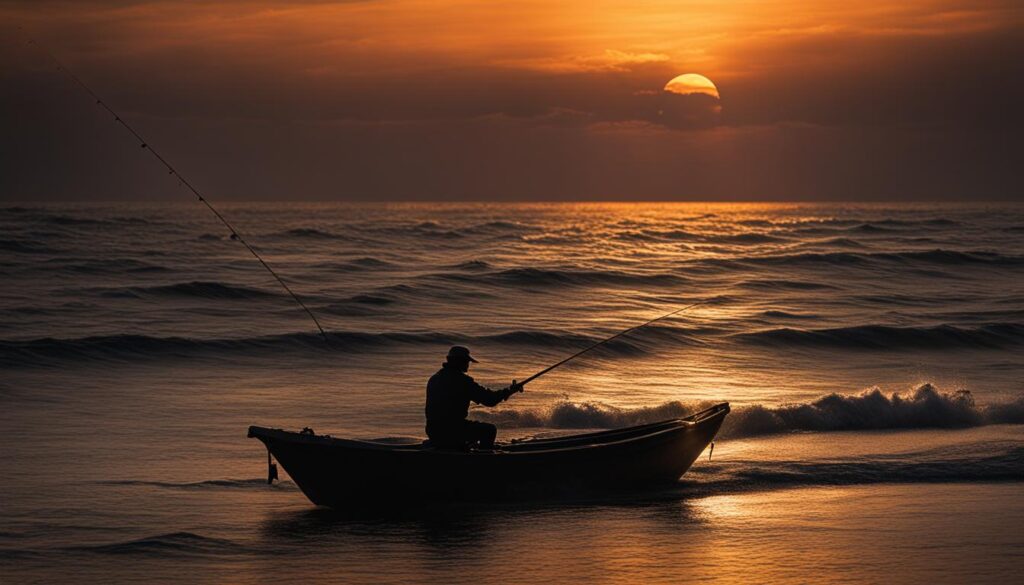We may earn money or products from the companies mentioned in this post.
Do you want to improve your chances of catching the best fish on your next outing? Look no further than our expert guide to fishing gear selection in the United States. Whether you’re a seasoned angler or just starting, selecting the right gear is crucial for a successful fishing trip. Our comprehensive guide will provide you with all the information you need to choose the best fishing equipment for your needs.
Key Takeaways
- Choosing the right fishing gear is essential to a successful fishing experience.
- Our guide provides expert advice on selecting the best fishing equipment in the United States.
- Whether you’re a beginner or experienced angler, our tips and recommendations will help you make informed decisions.
- Consider factors such as high-quality gear, essential accessories, and fishing gear reviews.
- Selecting the appropriate rod length, action, and material based on your fishing style and target species is crucial.
Understanding the Basics: Fishing Gear Components
Before diving into the vast array of fishing gear options available, it’s important to understand the fundamental components of fishing gear. Knowing these basics will lay a strong foundation for your gear selection process.
The Fishing Rod
The fishing rod is the backbone of your fishing gear. It is essential to choose a fishing rod that is appropriate for your fishing style and target species. The following are the key characteristics to consider when selecting a fishing rod:
- Length: Longer rods cast farther while shorter rods provide more precision.
- Action: The amount of flex in the rod, which affects the sensitivity and hook setting power.
- Material: Fiberglass and graphite are the most common materials, each with unique properties.
The Reel
The fishing reel is the spool that holds the fishing line and helps to retrieve it. There are several types of fishing reels, including spinning, baitcasting, and spincast reels. Consider the following when selecting your reel:
- Type: The type of reel you choose should be based on your experience level and target species.
- Size: The reel size should match the rod size to ensure balance and optimal performance.
- Drag: The drag system provides resistance to the fish, allowing you to tire it out and bring it in smoothly.
The Fishing Line
The fishing line is a critical component of your fishing gear that connects the rod and reel to the hook. There are several types of fishing lines to choose from, including monofilament, fluorocarbon, and braided lines. Consider the following when selecting your fishing line:
- Strength: The strength of the fishing line is measured in pounds and should match your target species.
- Visibility: The visibility of the fishing line varies by type and can impact the fish’s willingness to bite.
- Stretch: The amount of stretch in the fishing line affects the sensitivity and hook-setting power.
The Hooks
The hook is the pointy end of the fishing line that impales the fish. Hooks come in different sizes, designs, and materials, and selecting the right one is essential to your fishing success. Consider the following when selecting your hooks:
- Size: The size of the hook should match the bait and the fish’s mouth to maximize the catch rate.
- Design: Different hook designs have varying hooking and holding power. Select the one that matches your target species and fishing technique.
- Material: Hooks can be made of different materials, each with unique properties. Consider the water conditions and your target species when selecting the material.
“Understanding the basics of fishing gear components can greatly enhance your fishing experience. Selecting the appropriate fishing rod, reel, line, and hooks is fundamental to catching fish and enjoying the activity.”
Choosing the Right Fishing Rod and Reel
When it comes to selecting the best fishing gear, your choice of fishing rod and reel is critical. In this section, we will guide you through the process of choosing the perfect setup based on your preferences and fishing style.
Fishing Rod Selection
The right fishing rod can make a significant difference in your success on the water. Factors such as length, power, and action all play a crucial role in selecting the appropriate rod for your needs.
| Factor | Description |
|---|---|
| Length | The length of a fishing rod affects the casting distance, leverage, and overall sensitivity. Longer rods typically cast farther and provide more leverage to fight bigger fish. However, shorter rods offer more control and precision. |
| Power | The power of a fishing rod indicates its strength and how much weight it can handle. Light power rods are suitable for small fish, while heavy power rods can handle larger and stronger fish. |
| Action | The action of a fishing rod refers to its bending point. Fast action rods bend mostly at the tip, while slow action rods bend near the handle. Medium action rods provide a balance of sensitivity and power. |
Consider your fishing style and target species when selecting the appropriate rod. For example, if you plan to fish in freshwater for trout, a light power, fast action rod of 6-7 feet would be suitable. On the other hand, if you’re targeting saltwater species like tarpon, you might want a heavy power, medium action rod of 8-9 feet.
Fishing Reel Selection
The fishing reel is another critical component of your fishing gear. Reels come in different types and sizes, and each one is suitable for specific fishing techniques.
| Type | Description |
|---|---|
| Spincast Reel | Easy to use and suitable for beginners, these reels have a closed face and a button to release the line. They’re suitable for light tackle and small fish. |
| Spinning Reel | These reels have an open face and a bail for releasing the line. They’re versatile and can handle both light and heavy tackle. Spinning reels are suitable for various fishing techniques, including freshwater and saltwater fishing. |
| Baitcasting Reel | These reels are suitable for experienced anglers and heavy tackle. They provide greater accuracy and control but require practice to master. Baitcasting reels are suitable for techniques such as flipping, pitching, and trolling. |
| Fly Reel | These reels are suitable for fly fishing, where casting a weighted line is necessary. Fly reels have a simple design and are available in various sizes for different fish species. |
Consider your fishing style and the rod you’ve chosen when selecting the appropriate reel. For example, a spinning reel would pair well with a light power rod, while a baitcasting reel would pair well with a medium to heavy power rod.
When choosing your fishing gear, always prioritize high-quality equipment to ensure a successful and enjoyable fishing experience. Now that you’ve mastered the basics of fishing gear components, you’re ready to move on to selecting the perfect fishing line and hooks in our next section.
Selecting the Perfect Fishing Line and Hooks
When it comes to choosing the right fishing gear, the fishing line and hooks are crucial components. A high-quality fishing line and the appropriate hook can make all the difference in hooking and landing your catch.
There are several types of fishing lines available, including monofilament, fluorocarbon, and braided lines. Monofilament lines are the most common and versatile type, suitable for a wide range of fishing situations. Fluorocarbon lines are virtually invisible underwater, making them ideal for clear water conditions. Braided lines offer superior strength and sensitivity but are less stretchy than other types of line.
To select the perfect fishing line, consider the type of fish you are targeting, the fishing environment, and your personal preferences. It’s also essential to check the line’s line-test strength, diameter, and length to ensure it’s appropriate for your intended use.
Similarly, choosing the right fishing hook is crucial for your success. Hooks come in different sizes, designs, and materials, and each type has its advantages and disadvantages.
The hook size refers to the gap between the hook’s point and the shank, with larger numbers representing smaller hooks. A hook’s design can also vary, with some hooks having straight shanks while others have curved shanks. Materials used to make hooks can vary from steel to high-carbon steel and even titanium.
To choose the right hook, consider the target species, the fishing technique, and the bait you plan to use. Larger hooks are suitable for larger fish species and vice versa. Similarly, curved shanks are ideal for live bait while straight shanks work best for artificial lures.
Remember, choosing a high-quality fishing line and hook is crucial to your fishing success. Don’t skimp on these components, as they can make all the difference between a successful day on the water and coming home empty-handed.
Essential Fishing Accessories and Tackle
When it comes to fishing gear selection, having the right accessories and tackle can make all the difference. Here are some top-rated fishing accessories and essential tackle items to consider:
| Accessory/Tackle | Description |
|---|---|
| Fishing Tackle Box | A tackle box is an essential item for storing and organizing fishing gear. Look for a durable, waterproof option with plenty of compartments. |
| Fishing Net | A net can help you safely land your catch and prevent injury to both you and the fish. Consider the net size and material when making your selection. |
| Fishing Pliers | Pliers are useful for removing hooks, cutting line, and other tasks. Look for a sturdy pair with non-slip grips. |
| Fish Finder | A fish finder can help you locate fish and determine the depth of the water. Consider the display size, accuracy, and ease of use when selecting a model. |
When it comes to tackle, there is no one-size-fits-all solution. However, some essential items to consider for your fishing gear selection include:
- Lures: There are many types of fishing lures available, including crankbaits, spinners, and jigs. Consider the color, size, and action of the lure based on the type of fish you are targeting.
- Baits: Natural baits like worms, minnows, and leeches can be highly effective for catching fish. You can also use artificial baits like scented soft plastics or flies.
- Weights: Sinkers or weights are used to help your bait or lure sink to the desired depth. The weight you choose will depend on the type of fishing you are doing and the conditions.
Remember to consider the type of fishing you will be doing, the species of fish you are targeting, and the conditions of your fishing environment when selecting accessories and tackle for your fishing gear. A fishing gear buying guide can help you narrow down your options and make informed decisions.
Evaluating Fishing Gear Quality and Reviews
Choosing the right fishing gear can be overwhelming, but it’s critical to invest in high-quality gear that’s built to last. When it comes to evaluating fishing gear quality, there are several factors to consider.
Construction and Materials
The construction and materials of fishing gear play a key role in its quality and durability. Look for gear made from corrosion-resistant materials, such as aluminum or stainless steel, and pay attention to the way the pieces fit together. Loose or flimsy components can compromise the quality of the gear.
Customer Feedback and Reviews
“I always research customer reviews before investing in any fishing gear. It saves me time and money in the long run, and I know I’m getting a quality product.” – John, avid angler
Reading customer feedback and reviews is a critical step in evaluating fishing gear quality. Look for reviews from verified buyers and pay attention to comments about the gear’s durability, ease of use, and overall performance. Keep in mind that no product is perfect, so weigh the pros and cons of each review to make an informed decision.
Brand Reputation
The reputation of a fishing gear brand can also provide insight into the quality of its products. Look for brands with a history of producing high-quality gear, and do research to see if the brand has won any awards or accolades. A good brand reputation can be a strong indicator of a quality product.
By evaluating fishing gear quality and reviews, you can make informed decisions and invest in gear that will enhance your angling experience and stand the test of time.
Conclusion
In conclusion, selecting high-quality gear is crucial for any angler looking for a successful fishing experience. A proper gear selection process involves understanding the fundamental components of fishing gear, carefully evaluating the appropriate rod, reel, line, and hooks, and considering essential accessories and reviews. The right fishing gear can make a significant difference in your chances of reeling in a great catch.
When selecting fishing gear, it’s important to prioritize quality, durability, and suitability for your fishing style and target species. Taking the time to research and compare gear brands, materials, construction, and customer feedback can help you make informed decisions and avoid common pitfalls.
Remember, fishing is not just about catching fish; it’s also about enjoying the process. The right gear can make your fishing experience more comfortable, efficient, and fun. So, whether you are a beginner or an experienced angler, take the time to master your gear selection process, and enjoy the thrill of fishing with confidence.
Thank you for reading our Expert Guide to Fishing Gear Selection!
FAQ
Can I use the same fishing gear for freshwater and saltwater fishing?
It depends on the type of gear you have. Some fishing gear is designed for specific environments, such as freshwater or saltwater. Make sure to check the specifications of your gear and ensure it is suitable for the type of fishing you plan to do.
How do I know what fishing gear is best for beginners?
For beginners, it is recommended to start with a basic fishing rod and reel combo that is easy to use and offers versatility. Look for a medium power rod with a moderate action, paired with a spinning reel. This setup is great for learning the basics and can handle a wide range of fishing situations.
How do I choose the right fishing line strength?
The right fishing line strength depends on the type of fish you are targeting and the fishing technique you plan to use. As a general guideline, use lighter line (4-10 lb test) for smaller fish species and finesse fishing techniques, and heavier line (10-20 lb test) for larger fish and techniques that require more strength and abrasion resistance.
What fishing accessories are essential to have?
Some essential fishing accessories include a tackle box to organize your lures and hooks, a fishing net to land your catch, a pair of pliers to safely handle fish and remove hooks, and a fish finder to locate fish underwater. These accessories can greatly enhance your fishing experience and make your time on the water more efficient.
How can I evaluate the quality of fishing gear before buying?
To evaluate the quality of fishing gear, consider factors such as the brand reputation, construction materials, customer reviews, and warranty. Look for reputable brands known for producing high-quality gear, read customer reviews to get insights from other anglers, and check if the gear comes with a warranty for added peace of mind.
Affiliate Disclosure: This post may contain affiliate links. If you purchase through our link, we may receive a small commission, but at no additional cost to you. For more information, please see our Disclosure statement.



